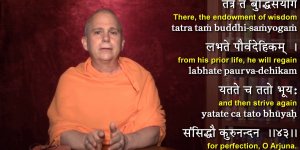| TV Channels / Documentaries |
Pancha Kosha: Five Sheaths that Cannot Cover Atma
A video presentation by Swami Tadatmananda Saraswati, Arsha Bodha Center, United States
(Tapescript) A striking image encountered by students of Vedanta is of the five koshas, the five sheaths that are said to cover or enclose your true self, atma, which is pure consciousness.
The outermost layer is the annamaya kosha, or food sheath - your physical body.
Within that is the pranamaya kosha, or energy sheath - the vital force that enlivens your body.
Inside that is the manomaya kosha, the mind sheath - where your thoughts, emotions and sensations reside.
Within that is the vijnanamaya kosha, the intellect sheath - the abode of your decisiveness, willpower, and ego.
Finally, the innermost layer is the anandamaya kosha - the so-called bliss sheath.
Illustrations like this one suffer from several mistakes. The influence of Western culture is obvious in the rainbow hues used for koshas that are actually colorless.
Another error is the depiction of atma, the true self, in the center of the figure, like the bull’s eye of a target. Atma is pure consciousness, which is vast, limitless, all-pervasive like space. Being all-pervasive, it can’t possibly be confined to a little spot enclosed by the five koshas. It would be more accurate to represent atma as the blue background.
But there’s still a problem here. If atma is all-pervasive, how can it be covered by the koshas? It’s impossible. Atma can’t be covered, contained or confined by anything.
Then, why are these five layers called koshas or sheaths?
As we will see, rather than covering atma, they actually cover knowledge, knowledge of atma, your true self.
To understand this better, we can find the very first scriptural reference to the koshas, in a section of the Yajur Veda known as the Taittiriya Upanishad.
There, it says: (chanting in Sanskrit) "Within the self made of food, the annamaya kosha, is another self, made of prana, the pranamaya kosha. The annamaya kosha is filled by the pranamaya kosha.”
The text goes on to describe how each kosha is filled by the next kosha.
This idea, that each kosha is filled by the next one, can be seen in these Russian nesting dolls. The outermost doll represents the annamaya kosha, your physical body. The doll inside represents the pranamaya kosha, your life force. The next doll represents the manomaya kosha, your mind. The next represents the vijnanamaya kosha, your intellect. And the innermost doll represents the anandamaya kosha, the bliss sheath.
The problem with this example is that it seems to imply that you are made of five layers with food or flesh as your outermost layer. But the Taittiriya Upanishad isn’t an anatomy book; it’s purpose is not to identify your inner bits and pieces. Its purpose is to lead you to discover your true nature, atma.
Shankaracharya, the great 8th century teacher of Vedanta, wrote a brilliant commentary on the Taittiriya Upanishad. He explains that your true nature is to be discovered by negating or removing each of the five koshas, one by one.
But, you can’t just strip off your five koshas like peeling away the layers of an onion. So, what does it mean to say, "the koshas must be removed?"
Shankaracharya describes the koshas, not as anatomical layers, but as five layers of ignorance, five levels of confusion. Each kosha is the focal point of wrong conclusions we make about ourselves, wrong conclusions that prevent us from discovering our true nature. Even though these sheaths can’t cover atma, they can cover or conceal a profound truth about the nature of atma.
To strip away the koshas is to remove our wrong conclusions and erroneous notions, one by one.
To explain this, my guru loved to tell a story about a famous, wealthy actor who played the role of a lowly beggar in a theatre production. While performing for a huge audience, he was treated with contempt by the other actors on the stage, who heartlessly ignored his pleas for help. Even though he was shunned and despised, he felt quite pleased with himself, because the audience was enjoying his dramatic performance and because he would soon receive a substantial payment for his acting work.
But suppose that actor was so deeply immersed in his role that he forgot he was acting and became completely identified with the character he portrayed. Then, he might feel outraged by the callous indifference of his fellow actors in the show, and he might shout at them in anger, chastising them for their insensitive behavior. By doing so, he would ruin the performance.
Sometimes, we too, become overly identified with our roles, roles like parent, spouse, doctor, manager, and so on. We usually take these roles very seriously, maybe too seriously.
For example, suppose a loving husband says good bye to his wife and goes off to work, where all day long, he plays the role of a combative, hard-hitting attorney. In the evening, when his wife expects her loving husband to return, imagine her confusion and frustration when a combative, hard-hitting attorney comes home instead!
Her husband’s over-identification with his work role can cause problems at home, just like the actor’s over-identification with his role can cause problems on the stage.
We are all subject to becoming overly identified with our roles. And when we do so, we often play our roles with much less skill, patience, and understanding. Not only that, when we deeply identify with our roles, the problems of those roles become our problems!
The actor took upon himself the problems of the beggar; the husband brought home the problems belonging to the attorney.
This leads to the central principle taught by the five koshas: whatever we identify with can become a source of suffering.
When we identify with our physical bodies, annamaya kosha, the problems of our bodies become our problems. If our true nature is pure consciousness, those problems don’t truly belong to us. But when we falsely identify with our bodies, we inherit their problems.
The same holds true for the other koshas. Each one is a locus of false identification.
For example, when your head throbs with pain, you don’t generally say, “My head hurts,” you say, “I have a headache.” If you lost use of your legs, you might say, “I am crippled.” When your body grows old, you’re likely to say, “I am old.” And when your body can no longer function, you might say, “I am dying.”
The pure consciousness which is your true nature doesn’t get headaches, nor can it become crippled, old, or near death.
Yet, due to false identification with your body, you’re likely to say, “I have a headache,” etcetera.
If you were completely free from such identification, you would know that even when your head throbs with pain, you are ok, because the pure consciousness, which is your true nature, isn’t affected by that headache at all.
When your body is tired, you often say, “I am tired.” If your body has been weakened by illness or old age, you might say, “I am weak.” But tiredness and weakness belong to your pranamaya kosha, not to you.
When sadness arises in your mind, you usually say, “I am sad.” And when your mind is agitated, you might say, “I am agitated.” But sadness and agitation belong to your mind, not to you.
When your intellect lacks the information needed to make a decision, you might say, “I’m confused.” If you feel no motivation to do anything at all, you could say “I am lazy.” Yet, confusion and laziness belong to your intellect, not to you.
In this way, each kosha is a locus of false identification. And whenever you identify with them, you adopt the all the problems of your body, prana, mind and intellect as your own.
Fortunately, the innermost kosha, the anandamaya kosha, doesn’t have any problems. To understand the anandamaya kosha, consider this: When you’re awake, all five koshas are present in your experience.
When you’re dreaming, your physical body, the annamaya kosha, ceases to be present in your experience.
And in deep sleep, none of the outer four koshas remain present in your experience. Only the anandamaya kosha remains, and that’s why you experience ananda or bliss.
But, when you wake up, you re-identify with the other koshas and become subject to their problems once again.
The point of all this is: when you falsely identify with your body, prana, mind or intellect, you embrace all their problems as your own. And they always have problems; such is the human condition.
But, if you identify instead as being pure consciousness, separate from the koshas and completely unaffected by whatever happens to them, then you can gain tremendous inner freedom.
So, the goal is not to go deeper and deeper, stripping away one kosha after another. The goal is to remove your identification with the koshas, so that you can remain entirely unaffected by their problems.
Then, you can abide in the knowledge that you are pure consciousness, full and complete, utterly independent of the five koshas.

Subscribe now to get unrestricted access to all resources, in all languages, throughout this web site!
Subscription Form
YOU MAY ALSO LIKE







Subscribe now to get unrestricted access to all resources, in all languages, throughout this web site!
Subscription Form